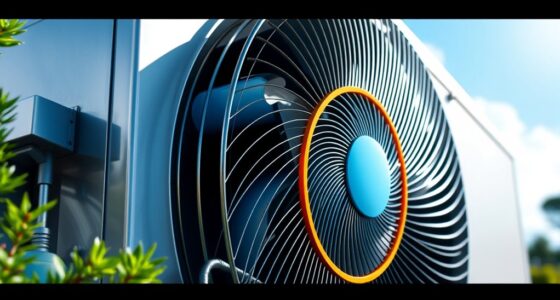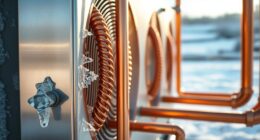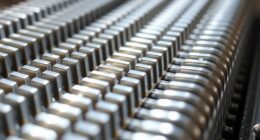Tired of high energy bills? We have the ideal answer for you!
In this article, we’ll show you how to choose high efficiency heat pumps that will maximize your energy savings. With our expert tips and advice, you’ll learn about the factors to consider, energy efficiency ratings, proper sizing and installation, and the benefits of inverter technology.
We’ll even explore advanced features and maintenance tips to ensure your heat pump stays energy efficient.
Don’t miss out on this opportunity to save money and serve the environment!

Key Takeaways
- Sizing considerations are crucial for adequate heating and cooling.
- Energy efficiency ratings like SEER and HSPF ensure optimal savings.
- Accurate sizing minimizes energy consumption.
- Proper installation by qualified technicians is crucial for optimal energy savings.
Factors to Consider When Choosing a High Efficiency Heat Pump
When we’re choosing a high efficiency heat pump, there are three key factors to consider: sizing considerations, installation tips, and energy efficiency ratings.
Sizing considerations are crucial to ensure that the heat pump is capable of providing adequate heating and cooling for the space it will be installed in. It’s important to calculate the heat load and cooling load of the area to determine the appropriate size of the heat pump.
Additionally, installation tips are essential for maximizing the efficiency of the heat pump. Proper positioning, insulation, and ductwork can greatly impact the performance of the heat pump.
Lastly, energy efficiency ratings such as SEER (Seasonal Energy Efficiency Ratio) and HSPF (Heating Seasonal Performance Factor) should be considered to ensure optimal energy savings.

Understanding Energy Efficiency Ratings for Heat Pumps
We should also understand the energy efficiency ratings for heat pumps in order to make informed decisions about our purchases.
Energy efficiency certifications provide valuable information about the performance and efficiency of heat pumps. One common certification is the Energy Star label, which indicates that a heat pump meets or exceeds strict energy efficiency guidelines set by the U.S. Environmental Protection Agency.
Another important factor to consider is the heat pump’s coefficient of performance (COP). COP is a measure of the heat pump’s efficiency and indicates how much heat the pump can produce for each unit of electricity consumed. The higher the COP, the more energy efficient the heat pump is.
When comparing different heat pumps, it’s crucial to understand their energy efficiency ratings and COP to ensure maximum energy savings.

Sizing Your Heat Pump for Maximum Energy Savings
To achieve maximum energy savings, we must accurately size our heat pump and ensure it’s neither too big nor too small for our heating and cooling needs. Proper sizing is crucial in minimizing energy consumption and optimizing efficiency.
An undersized heat pump will struggle to meet the desired temperature, leading to increased energy usage as it works harder to compensate. On the other hand, an oversized heat pump will cycle on and off frequently, consuming unnecessary energy and causing wear and tear on the system.
To determine the proper sizing, we need to consider factors such as the climate, insulation levels, and the size and layout of the space being conditioned. Conducting a thorough load calculation and consulting with a professional HVAC technician can help ensure the heat pump is sized correctly, resulting in maximum energy savings.
The Importance of Proper Installation for Energy Efficiency
Properly installing our heat pump is essential for achieving optimal energy efficiency and should be done by a qualified technician. Here are some key reasons why proper installation techniques and professional installation services are crucial:

-
Correct sizing: An experienced technician will ensure that the heat pump is properly sized for your home, taking into account factors such as square footage, insulation, and climate. This ensures that the system operates efficiently and effectively.
-
Proper placement: The location of the heat pump plays a significant role in its performance. A professional installer will consider factors like airflow, noise, and accessibility when determining the ideal placement for the unit, maximizing its energy efficiency.
-
Correct installation procedures: A qualified technician will follow industry best practices and manufacturer guidelines when installing the heat pump. This includes correctly connecting electrical components, refrigerant lines, and ductwork, ensuring that the system operates at its peak efficiency.
Exploring the Benefits of Inverter Technology in Heat Pumps
The benefits of inverter technology in heat pumps include increased energy efficiency and improved comfort. Inverter technology allows the heat pump to continuously adjust its heating or cooling capacity based on the current demand. This results in more precise temperature control and reduced energy wastage.

Traditional heat pumps operate at fixed speeds, which means they constantly turn on and off to maintain the desired temperature, leading to energy inefficiency. In contrast, inverter technology allows the heat pump to modulate its speed and power consumption, resulting in significant energy savings potential.
Additionally, the continuous operation of the heat pump with inverter technology provides a more consistent and comfortable indoor environment. With the ability to adapt to changing conditions, inverter technology ensures optimal performance and energy efficiency.
Now, let’s explore how to evaluate the SEER and HSPF ratings of high efficiency heat pumps.
Evaluating the SEER and HSPF Ratings of High Efficiency Heat Pumps
When evaluating high efficiency heat pumps, it’s important to consider the SEER and HSPF ratings.

The SEER (Seasonal Energy Efficiency Ratio) measures how efficiently a heat pump can cool a space, while the HSPF (Heating Seasonal Performance Factor) measures its heating efficiency.
Both ratings are crucial in determining the energy efficiency of a heat pump and its potential for energy savings.
Understanding and comparing these ratings will help homeowners make informed decisions when choosing a high efficiency heat pump for maximum energy savings.
SEER Vs HSPF Comparison
In evaluating the SEER and HSPF ratings of high efficiency heat pumps, we need to compare their energy-saving capabilities. When considering the efficiency of a heat pump, it’s important to understand the differences between SEER (Seasonal Energy Efficiency Ratio) and HSPF (Heating Seasonal Performance Factor) ratings.

Here are three key points to consider when comparing heat pump ratings:
-
SEER Efficiency: SEER measures the cooling efficiency of a heat pump. The higher the SEER rating, the more efficient the heat pump is at cooling. Look for a heat pump with a high SEER rating to maximize energy savings during the cooling season.
-
HSPF Efficiency: HSPF measures the heating efficiency of a heat pump. A higher HSPF rating indicates greater heating efficiency. For optimal energy savings during the heating season, choose a heat pump with a high HSPF rating.
-
Balanced Efficiency: Both SEER and HSPF ratings are important for overall energy efficiency. Consider a heat pump that offers a balance between high SEER and HSPF ratings to ensure year-round energy savings.

Energy Efficiency Standards Explained
Let’s evaluate the SEER and HSPF ratings of high efficiency heat pumps to understand energy efficiency standards.
Energy efficiency regulations have become increasingly important as society strives to reduce energy consumption and mitigate the impact of climate change.
The SEER (Seasonal Energy Efficiency Ratio) rating measures the cooling efficiency of a heat pump, while the HSPF (Heating Seasonal Performance Factor) rating measures its heating efficiency.
Higher SEER and HSPF ratings indicate greater energy efficiency and lower operating costs.

Energy efficient technology advancements have led to heat pumps with higher SEER and HSPF ratings, allowing homeowners to save more on their energy bills.
When choosing a high efficiency heat pump, it’s crucial to consider both the SEER and HSPF ratings to ensure maximum energy savings and reduce environmental impact.
Comparing Different Heat Pump Models for Energy Savings
We can compare different heat pump models to maximize energy savings. When evaluating the options, consider the following factors:
-
Heat pump installation process: Look for models that are easy to install and come with clear instructions. This will help minimize installation time and costs.

-
Energy saving thermostat settings: Some heat pump models offer advanced thermostat settings that allow you to control and optimize energy usage. Look for features like programmable schedules, temperature presets, and smart home integration.
-
Efficiency ratings: Compare the Seasonal Energy Efficiency Ratio (SEER) and Heating Seasonal Performance Factor (HSPF) ratings of different models. Higher ratings indicate better energy efficiency and potential for savings.
By comparing these factors, you can choose a heat pump model that not only meets your heating and cooling needs but also helps you save on energy costs.
Now let’s explore some tips for maintaining your high efficiency heat pump’s energy efficiency.

Tips for Maintaining Your High Efficiency Heat Pump’s Energy Efficiency
When it comes to maintaining the energy efficiency of your high efficiency heat pump, there are several key points to keep in mind.
Regular maintenance is crucial to ensure optimal performance and energy savings.
Following energy-saving best practices and troubleshooting common issues can also help to maximize the efficiency of your heat pump.
Regular Maintenance Requirements
Regularly maintaining your high efficiency heat pump is crucial for ensuring maximum energy efficiency. This can be done by scheduling professional inspections and cleanings at least once a year. Here are some energy-saving tips to keep your heat pump running efficiently:

- Keep the outdoor unit clear of debris and vegetation to ensure proper airflow.
- Clean or replace air filters regularly to maintain optimal airflow and prevent dust buildup.
- Check and clean the evaporator and condenser coils to remove dirt and debris that can hinder heat transfer.
By following these maintenance tips, you can improve the energy efficiency of your high efficiency heat pump and reduce your energy consumption.
In the next section, we’ll discuss energy-saving best practices that go beyond regular maintenance to further maximize your savings.
Energy-Saving Best Practices
Maintaining a consistent temperature in your home is key to optimizing your high efficiency heat pump’s energy efficiency. Here are some energy-saving tips to help you reduce energy consumption and maximize the performance of your heat pump.
Firstly, it’s important to regularly clean or replace the air filters in your heat pump. Clogged filters can restrict airflow and reduce efficiency.

Secondly, ensure that your home is properly insulated. Insulation helps to keep the warm air inside during winter and the cool air inside during summer, reducing the workload on your heat pump.
Additionally, consider using a programmable thermostat to control the temperature in your home. This allows you to set different temperatures for different times of the day, ensuring that your heat pump operates efficiently when needed.
Lastly, schedule regular maintenance checks with a professional technician. They can inspect and clean your heat pump, ensuring that it’s functioning optimally and identifying any potential issues before they become major problems.
Troubleshooting Common Issues
To ensure maximum energy efficiency, we recommend regularly checking for common issues and addressing them promptly. Here are some common troubleshooting techniques to help you identify and resolve common heat pump issues:
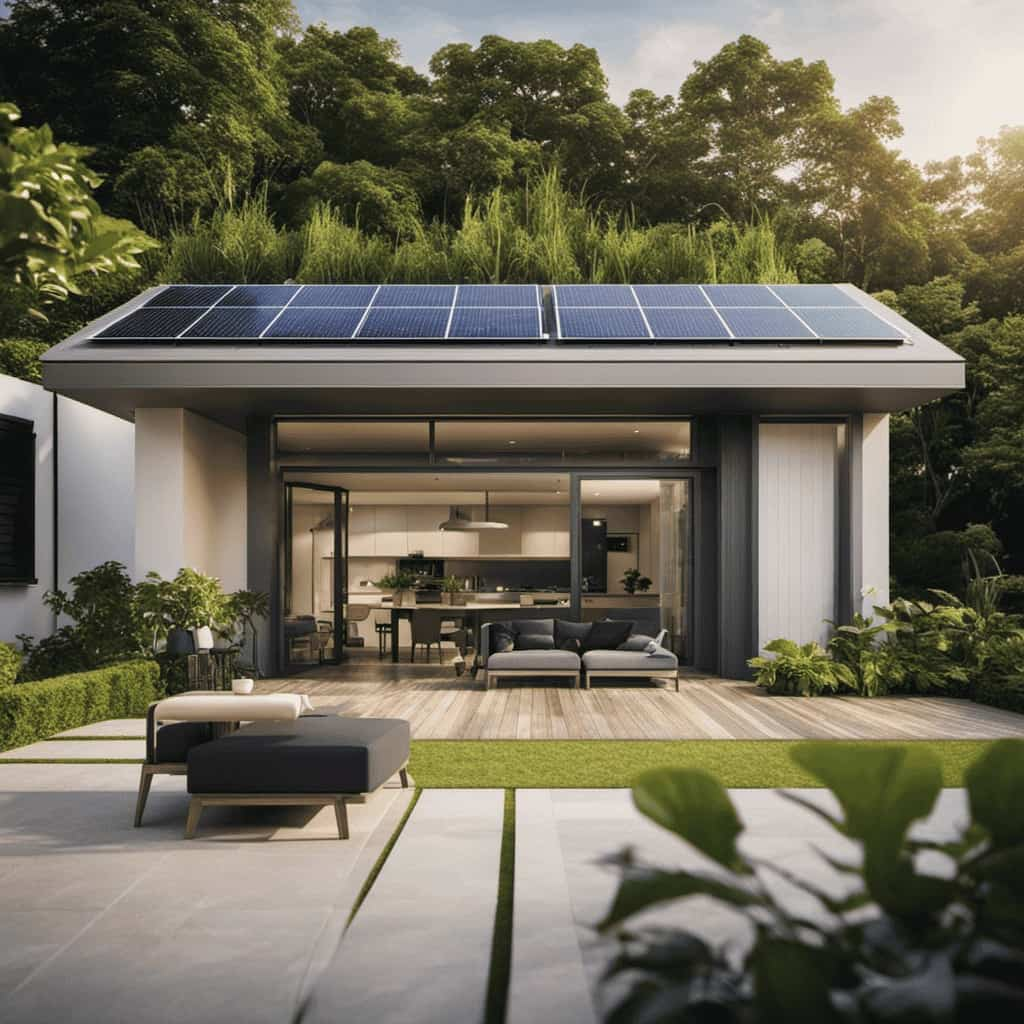
-
Check the air filters regularly and clean or replace them as needed. Clogged filters restrict airflow and reduce efficiency.
-
Inspect the outdoor unit for any debris or obstructions that may hinder proper airflow. Clear away any leaves, dirt, or other debris.
-
Monitor the thermostat settings to ensure they’re accurate and properly calibrated. Incorrect settings can lead to unnecessary energy consumption.
By following these troubleshooting techniques, you can proactively maintain your high efficiency heat pump’s energy efficiency and prevent potential issues from escalating.

Now, let’s delve into understanding the role of insulation in heat pump energy efficiency.
Understanding the Role of Insulation in Heat Pump Energy Efficiency
When installing a heat pump, we should prioritize understanding the role of insulation in maximizing energy efficiency. Proper insulation plays a crucial role in reducing heat loss and ensuring that the heat pump operates at its optimal efficiency levels. There are various types of insulation materials available, each with its own unique properties and benefits. Let’s take a look at a comparison table to understand the different insulation types and their characteristics:
| Insulation Type | R-Value per inch | Material Composition |
|---|---|---|
| Fiberglass | 2.2 – 4.3 | Glass fibers |
| Cellulose | 3.2 – 3.8 | Recycled paper |
| Spray Foam | 3.6 – 8.0 | Polyurethane |
| Mineral Wool | 3.0 – 4.0 | Rock or slag fibers |
| Reflective | 1.1 – 3.5 | Foil or plastic film |
As we can see, different insulation materials offer varying levels of thermal resistance (R-Value) per inch. It is important to choose the right insulation type and thickness based on your climate and specific heat pump requirements. With proper insulation, we can minimize heat loss, improve energy efficiency, and reduce utility bills. Now let’s move on to exploring advanced features for energy savings in high efficiency heat pumps.
In the subsequent section, we will delve into the advanced features of high efficiency heat pumps that can further enhance energy savings.

Exploring Advanced Features for Energy Savings in High Efficiency Heat Pumps
Let’s delve into the advanced features of high efficiency heat pumps that can help us maximize energy savings. These advanced technologies and energy-saving techniques are designed to optimize the performance of heat pumps and reduce energy consumption.
Here are three key features to consider:
-
Variable Speed Compressors: These advanced compressors adjust their speed based on the heating or cooling demand, allowing the heat pump to operate more efficiently. By matching the output to the required load, variable speed compressors can save energy and provide more precise temperature control.
-
Smart Thermostats: Integrated with advanced algorithms and sensors, smart thermostats can learn your heating and cooling preferences and make automatic adjustments to optimize comfort and energy efficiency. They can also be controlled remotely through smartphone apps, allowing you to adjust settings even when you’re away from home.

-
Energy Recovery Ventilators: These devices recover energy from the outgoing air and use it to pre-condition the incoming fresh air. By exchanging heat and moisture between the two air streams, energy recovery ventilators help maintain indoor air quality while reducing the load on the heat pump.
Frequently Asked Questions
Can I Install a High Efficiency Heat Pump Myself or Is Professional Installation Necessary?
When considering DIY installation for a high efficiency heat pump, it’s important to weigh the potential cost savings against the risks. Professional installation ensures optimal performance, efficiency, and safety, making it the recommended choice for maximum energy savings.
Are There Any Tax Credits or Rebates Available for Purchasing a High Efficiency Heat Pump?
Yes, there are tax credits and energy efficiency incentives available for purchasing a high efficiency heat pump. These incentives can help offset the cost and encourage the use of more energy-efficient heating options.
How Long Does a High Efficiency Heat Pump Typically Last?
Heat pumps typically last 15-20 years, but high efficiency heat pumps have a longer lifespan due to their advanced technology and quality construction. They reduce energy costs and provide numerous advantages for homeowners.

Can a High Efficiency Heat Pump Be Used for Both Heating and Cooling Purposes?
Yes, high efficiency heat pumps can be used for both heating and cooling purposes. They offer several advantages, such as energy savings and the ability to compare different models based on their efficiency ratings.
Are There Any Specific Maintenance Requirements for a High Efficiency Heat Pump That I Should Be Aware Of?
Are there specific maintenance requirements for high efficiency heat pumps? Yes, regular filter cleaning, coil inspection, and refrigerant level checks are common tasks. Neglecting maintenance can lead to decreased efficiency and potential issues.
Conclusion
In conclusion, choosing a high efficiency heat pump can greatly maximize energy savings in your home.
By considering factors such as energy efficiency ratings, proper sizing, installation, and advanced features like inverter technology, you can ensure optimal energy efficiency.
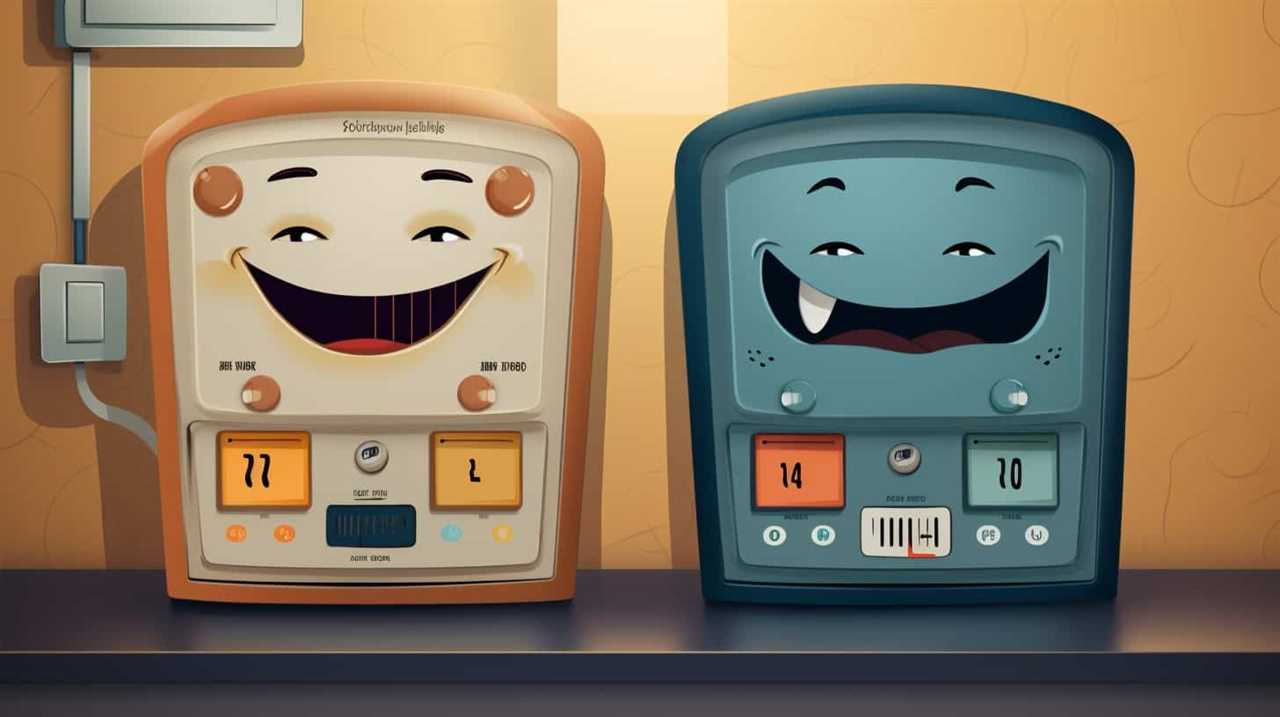
Regular maintenance and insulation also play a crucial role in preserving the heat pump’s energy-saving capabilities.
With the right heat pump model and practices, you can enjoy both comfort and significant energy savings in your home.



